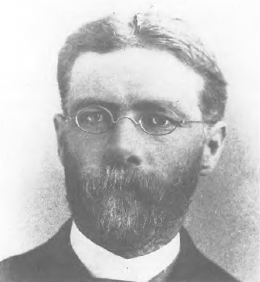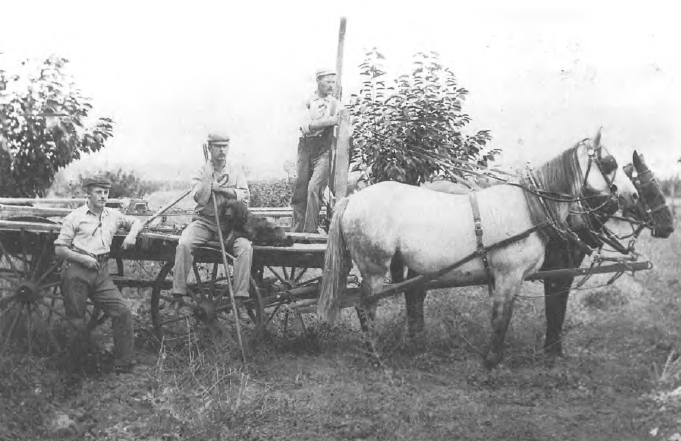News & Events More |
FormationThe address by Allan in Vancouver seems to have galvanized interest in an organization for fruit growers, for it was only three months later, on February 1, 1889, that a meeting was held at the Vancouver Board of Trade rooms "to discuss the propriety of forming a Fruit Growers' Association for this Province." Oddly enough, the leading organizer seems to have been Mayor David Oppenheimer of Vancouver, who was a wholesale grocer and who, as far as can be determined, was not a fruit grower. But he was the mayor of a very energetic and ambitious new city which had sprung up vigorously after being obliterated by the great fire of 1886. As a real estate investor, he was eager to encourage any new industry which would increase demands for agricultural land and build production which could be funnelled through the new metropolis of the west. For similar reasons, in 1888 he had arranged for the city to distribute sugar beet seed to local farmers and tried to arrange the establishment of a sugar beet refinery in the city. Several others who attended the organizational meeting also had non-agricultural occupations: J.M. Browning, who was elected the Association's first president, was the Land Commissioner for the Canadian Pacific Railway (but he had previously been an active member of the Montreal Horticultural Society and Fruit Growers' Association of Quebec). R.E. Gosnell was a newspaper editor, and George Grant McKay, who was elected B.C.F.G.A. director for Vancouver city and vicinity, was a high-powered land promoter of whom it was said "that when he died, and the gates of heaven opened up for him, he would seize St. Peter by the lapel and say to him, 'How are the chances of laying out a townsite here?' So, "pursuant to notices and advertisements a respectable attendance was present" on February 1, 1889. The first order of business was the formal creation of the Association. A motion was put and carried to form the "British Columbia Fruit Growers' Association". Then officers were elected, unanimously in every case: President, J.M. Browning, Vancouver 1st Vice-President, Thos. Cunningham, New Westminster 2nd Vice-President, G.W. Henry, Maple Ridge Secretary-Treasurer, A.H.B. MacGowan. The Board of Directors consisted of twenty-nine members, largely from the Lower Mainland and Vancouver Island, but including Alfred Postill representing the Okanagan and A.L. Fortune from the Spallumcheen district. Only eight of the directors elected were actually present at the meeting; the others were selected in absentia because it was thought they would be appropriate (both Postill and Fortune appear to have been in this category). Vignette: Alfred Postill, First Okanagan B.C.F.G.A. MemberAlfred Postill, the first Okanagan member of the B.C.F.G.A., was born in England in 1852. He came to Canada with his parents, first to Ontario and then to British Columbia. The family was travelling to a ranch at the foot of Duck Lake, which Postill had gone on ahead to purchase, when his father, Edward, fell ill at Kamloops and died at Priests' Valley (now Vernon) in 1872. Young Postill, with two other brothers, took on the operation of the ranch his father never saw, expanding it to about 5000 acres and building a sawmill.1 While cattle remained the main focus of the Postill Ranch, with 1500 head on the range by 1891, it also included sheep, pigs, fifty acres of wheat, and a small apple orchard.  Alfred Postill Courtesy Kelowna Centennial Museum Alfred Postill was a firm believer in progressindeed, he seems to have been at least a decade ahead of his time. Among other projects, in 1891 he installed the first telephone system in the Okanagan, a private line linking his own home, his brother William's, and the neighbouring ranch of Thomas Wood of Winfield. Just under five miles long, the wire ran on the east side of Duck Lake and cost $55 per mile. Postill was the first in the Okanagan to plant alfalfa, and he even tried growing peanuts, some of which he exhibited at the Vernon Fair in 1896. One of the first advocates of cooperative marketing in the Okanagan, in the autumn of 1893 he called a meeting at Benvoulin school house. The meeting resulted in the farmers of Kelowna beginning a cooperative selling venture. They jointly established a warehouse and root cellar at Sandon to sell fruit and vegetables in the mining country of the Kootenays. He continued to espouse the cooperative cause and told the Agricultural and Trades Association of Okanagan Mission Valley that if farmers organized: With increasing vision, he proposed that farmers work together to build telephone lines, cold storages and warehouses, all capped by an electric tram line to carry the produce from the farms to the packing plants. He was a leader by nature, and might have brought about more innovations in the Okanagan had he not died at the early age of forty-five on September 26, 1897. The meeting then settled down to business. The first resolution before the newborn B.C.F.G.A. set a long-standing precedent, for it dealt with the government and money. Mayor Oppenheimer moved that: whereas the Fruit Growers' Association of British Columbia has been established and the revenues and means of the said Fruit Growers' Association are somewhat limited and inadequate to defray the expenses necessarily incurred by an association of such vital importance to the Province as the Fruit Growers' Association of British Columbia, be it therefore resolved that the Provincial Government be requested to aid and assist the Fruit Growers' Association of British Columbia with an annual grant of $1800 (eighteen hundred) similar to the appropriation made by the Government of the Province of Ontario for the Fruit Growers' Association of Ontario. Carried. This was followed by another resolution that, as it was "of the greatest importance to the interests of the Fruit Growers' Association of British Columbia" to be represented at the forthcoming Dominion fruit growers' conference, planned for January, 1890, in Montreal or Toronto, the Association should ask the federal government for funds to cover delegates' expenses. The matter of the B.C.F.G.A. constitution was dealt with next. With slight changes, the meeting adopted the constitution and bylaws of the Montreal Horticultural Society and Fruit Growers' Association of the Province of Quebec. The object of the Society shall be to encourage the cultivation of flowers, fruits, vegetables and pursuits pertaining to horticulture, the promotion of bee culture, holding of exhibitions and collecting information regarding the different varieties of fruits best adapted for cultivation in this Province. The structural arrangements called for the annual meeting to be held in January, with quarterly directors' meetings. Membership fees were set at $2 per year, with life memberships for $20. With the more formal business done, various fruit growers shared their horticultural experiences. Thomas Cunningham of New Westminster, G.W. Henry of Maple Ridge, E. Hutcherson of Ladner, and William Perkins of Mission recommended varieties of berries and fruit to plant, pruning methods, and ways of dealing with pests. Mr. Cunningham said that "a sovereign remedy against many of them was to wash the trees with soft soap, diluted to the proportion of 1 to 6 with water," and concluded by saying that: He was enthusiastic in the matter of fruit growing. It was an elevating profession, and had excellent moral effects. He never saw a bad man engaged in horticulture. (Laughter). In talking to the warden of the penitentiary the other day, he asked him how many fruit growers they had in the penitentiary, and the reply was "Not one!" It brought men in harmony with nature and nature's God. It was helping the work of the Creator, and through it was divined the operation of His laws. The following morning, Saturday, February 2, 1889, the Board of Directors (at least those in Vancouver) met to decide various working details of the Association. Housekeeping and accounting procedures were approved, and the directors decided to inquire about affiliation with the Ontario Fruit Growers' Association in order to receive the publications which that organization distributed. The only serious discussion was on the question of exhibitions. E. Hutcherson objected to the B.C.F.G.A. holding public exhibitions at all, since there was an Agricultural Association already doing so, but the president reminded him that the holding of exhibits was a stated constitutional object of the B.C.F.G.A.
Some members pointed out that the climate varied so in the different localities that the season for the ripening of the fruit was not the same, and that therefore an exhibition could not be held at which displays from all the districts would be made. Other difficulties were mooted, but the president stopped them by stating that the Association would have a large contract on their hands if they began to provide for every difficulty before it occurred.” After more wrangling about which fruits and crops were most important and should therefore have the date of the exhibition fixed to suit them, the directors finally decided to hold one exhibition that year, at Vancouver, on the first Tuesday in August, in conjunction with the quarterly Directors' meeting. Contact Us Hours: 9am - 4pm weekdays. t: 250-762-5226 |


